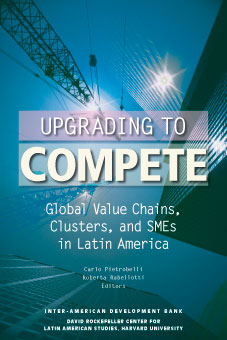Published by Harvard University Press
Edited with Carlo Pietrobelli
This books investigates clusters and value chains in Latin America. Globalization imposes new conditions and rules for competitiveness in international markets. It poses the imperative to link up with other actors, both at the local and at the global level, and find new ways to interact and learn from the relationship. Can local markets and clusters represent a powerful alternative to global markets? Do transnational corporations and global buyers play a role and enhance or undermine local firms’ upgrading and learning? What opportunities do clustering and global value chains offer to SMEs in global markets?
Upgrading to Compete shows that both the local and the global dimensions matter at once. Clustering and collaborating with other local firms offers substantial advantages, while also participating in global value chains and interacting with foreign buyers and companies may enhance local firms’ capabilities and access to distant markets. However, what remarkably matters is the form of governance of value chains and clusters that importantly affects the upgrading process of local SMEs.
The book illustrates this with original empirical evidence from several clusters in Latin America. New case studies from Brazil, Chile, Mexico and Nicaragua are supplemented by desk studies on other experiences in the region.
«At a time when there is growing interest in Latin America on active production sector strategies and on the role of SMEs, Pietrobelli and Rabellotti make in this book an essential contribution. “Upgrading to Compete” is full of quality information and insights. I look forward for the introduction of many of the ideas and recommendations of this book into policy action.»
Jose Antonio Ocampo
Under-Secretary-General of the United Nations for Economic and Social Affairs
«This book offers a new way of thinking into fundamental aspects of industrial organization and international trade and exploits original case studies to develop new ideas and stylized facts.»
Michael Piore
David W. Skinner Professor of Political Economy, Massachusetts Institute of Technology
The book was reviewed in Foreign Affairs
You can buy the book here

